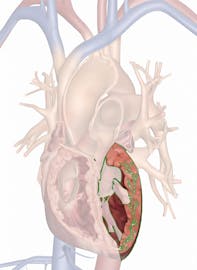The Left Ventricle
Explore the anatomy and role of the left ventricle in the circulatory system with Innerbody's 3D model.

The left ventricle is one of the four chambers of the human heart. It plays a vital role in the circulatory system by pumping oxygenated blood from the heart to all body tissues. The muscular walls of the left ventricle are by far the largest and strongest of the heart.
Anatomy
The human heart consists of four chambers: the left and right atrium and the left and right ventricle. Each chamber is a hollow cavity surrounded by a muscular wall. The left ventricle is the chamber on the lower left side of the heart, inferior to the left atrium.
The exterior of the left ventricle is continuous with the surface of the heart and is a layer of simple squamous epithelium known as the epicardium. The epicardium provides a smooth, slick surface layer that prevents friction between the heart and the surrounding tissues. The thick, muscular middle layer is the myocardium. The myocardium in the left ventricle is thicker than all other heart regions, making the left ventricle extremely strong. Cardiac muscle cells in the myocardium are connected to the heart's conduction system by Purkinje fibers and are supported by a flexible skeleton of collagen fibers. The interior surface of the left ventricle is lined with a layer of simple squamous epithelium known as the endocardium. The endocardium plays a vital role in the heart by forming a smooth, continuous layer that prevents blood clots from forming and reduces friction between blood and the heart wall.
Physiology
Systole, or contraction, of the left ventricle begins when electrochemical signals from the heart’s pacemaker arrive in the Purkinje fibers spread throughout the myocardium. These signals, in the form of sodium ions, trigger the cardiac muscle cells in the myocardium to contract. The cells in the inferior region of the left ventricle receive the signal first, resulting in a wave of contraction that begins at the inferior end and terminates at the superior end. As the cardiac muscle cells contract, they decrease the volume and increase the blood pressure within the left ventricle. Blood surges toward the superior end of the chamber, lifting the cusps of the bicuspid valve into their closed position and preventing blood from flowing to the left atrium. With the pathway to the left atrium blocked, blood flows through the open aortic valve and enters the lumen of the aorta. At the end of the ventricular systole, almost all of the blood has been pumped out of the left ventricle, and the myocardium begins to relax. During this relaxation, known as ventricular diastole, the bicuspid valve reopens to allow blood from the left atrium to fill the left ventricle. The aortic valve closes due to the blood pressure in the aorta, preventing blood from regurgitating back into the left ventricle.


